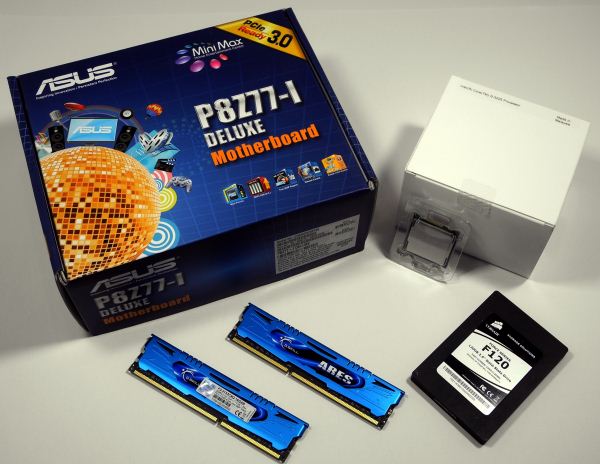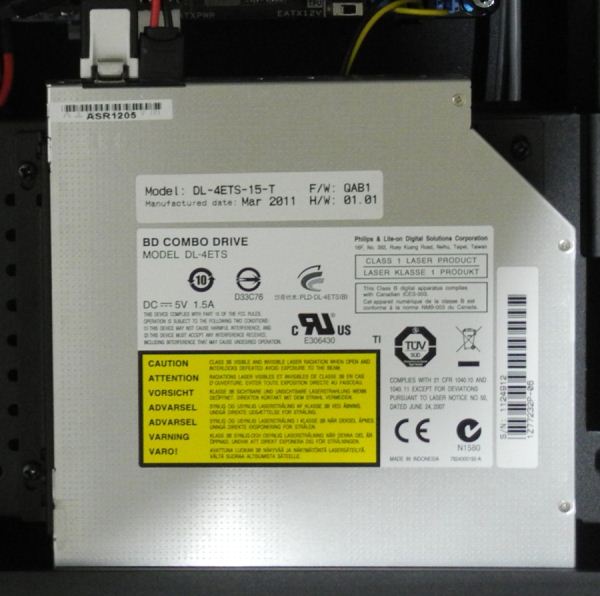Streacom's FC10 and Nano150: Building a Fanless Ivy Bridge HTPC
by Ganesh T S on December 22, 2012 3:30 AM EST- Posted in
- HTPC
- Fanless
- Ivy Bridge
HTPC Testbed Components
In choosing the Streacom FC10 and Nano150 as the chassis and PSU for our testbed, we were practically restricted to a mITX or uATX motherboard. There was a toss up between building a Trinity-based testbed and a Ivy Bridge-based testbed. In the end, the fact that Trinity emerged as being a capable madVR candidate (with software based decoding), and the fact that madVR recently introduced DXVA scaling (an upside for Intel since its offerings weren't fully madVR capable earlier, and something that we wanted to test out) persuaded us to go for an Intel-based testbed.
Processor:
Intel's best GPU offering to date is the HD 4000, and the cheapest Ivy Bridge with the HD 4000 GPU is the Core i3-3225. The Core i3-3225 is a 2C/4T processor with a 55W TDP. It has a 3 MB L3 cache, and can run at 3.3 GHz. The HD4000 runs at 650 MHz by default, but, can turbo up to 1050 MHz when necessary. Like all other Ivy Bridge processors, we have support for DDR3-1600 memory.
Motherboard & Chipset:
The Asus P8Z77-I Deluxe is a Z77-based mITX motherboard with integrated dual-band Wi-Fi / Bluetooth and plenty of HTPC oriented features with Wi-Fi GO!, including the ability to interact with the PC using a mobile device, making it act as a DLNA media hub and so on. This video from Asus captures the capabilities included in the Wi-Fi GO! feature. Ian will be presenting a detailed review of the P8Z77-I Deluxe. However, in the context of our HTPC testbed, the motherboard fulfills all our primary requirement that at least one free PCIe slot be available for installation of a discrete GPU at a later point in time.
Asus also has a Wi-Di enabled model with an Intel Wi-Fi adapter instead of the Broadcom-based one in the P8Z77-I Deluxe.
Memory:
We had used the G.Skill Ares kit in our Trinity HTPC testbed, and given the fact that it can run even at 2133 MHz, we decided to use the same model for this system build also. As a refresher, the DRAM runs with a 9-11-10-28 latency configuration. We also decided to use only one module to give the system 4 GB of DRAM. The reason to not go in for 8 GB will be made clear in the next section.
Primary & Optical Disk Drives:
We used one of the old SSDs lying around, the Corsair F120 120GB. Our intent was to use the SSD only for the OS and program files, and leave all the media on a NAS in another location. Installing a hard drive for increased capacity was ruled out because we wanted a silent HTPC.
One of the constraints posed by the FC10 chassis was the fact that we could only use a slot-loading optical drive. Despite the fact that we wanted a silent system, we did make one concession and decided to install a ODD in the system. Some of our ASRock HTPC samples are now being used as headless systems for network testing, and we decided to take out a Blu-ray drive (Philips Lite-On DL-4ETS) from one of those and use it in our HTPC testbed.


















63 Comments
View All Comments
brakteat - Saturday, December 22, 2012 - link
LauRoman is right. Last year I built four fanless computers for our office, using HD-Plex H3.S chassis. Since then they run fast (Core i3-2105+SSD), completely silently (no moving parts) and still very cool (under load, all components are usually below 55 C). Also, after one year there is no visible dust inside the chassis so there is no need for physical maintenance.Of course, if you want to play games at high resolution then HD 4000 is certainly not enough (and my HD 3000 even less so). I always play my games at 2560x1600 and built myself an inaudible gaming computer in a Coolermaster HAF-X. This works great thanks to seven large fans running at low speed. The graphics card is ony cooled by a 200 mm fan. The fans do collect a lot of dust though, even if the case has dust filters. Without maintenance the dust would eventually stop the computer from working.
EnzoFX - Saturday, December 22, 2012 - link
TRUE. The single best reason to go for passive is no dust. Can't argue against someone wanting zero maintenance.Death666Angel - Saturday, December 22, 2012 - link
I have an HTPC with one fan that serves double duty as the cpu heatsink fan and the case fan (I cut a large hole above into the case above the heatsink so the fan could get fresh air), I also have a dust cover just above it that works with magnets. Every time my wife or I vacuum the living room, we just take it off, vacuum it as well and put it back on. nearly zero maintenance and much more powerful if I wanted to. Also, silent in the current setup. I would never go with a fanless case.But I do see that for some people/situations, adding fans does not bring anything to the table because they just don't need the power or cooler running components. :)
EnzoFX - Saturday, December 22, 2012 - link
Yes exactly. Some people really want zero maintenance, and aren't going to be gaming on it =P. I myself am drawn to such a setup, but I've never been able to commit, and probably never will. So it does go to show that it's impractical for more hands-on users, seeing as with just a little work, you get much more in return.colonelciller - Sunday, December 23, 2012 - link
this case is perfect for playing 1080 P video streamed from a home media server (in another room).looks like a ZERO compromise machine to people who want silence.
For those who want a do-it-all noise maker next to there TV there are other cases.
ryccoh - Saturday, December 22, 2012 - link
Check out Silverstone cases. They like to mount two slow 180mm fans on the buttom blowing air out the top of the case with the motherboard turned 90 degrees.colonelciller - Sunday, December 23, 2012 - link
No no no absolutely NOTThe whole point of this case is silence with a capital 'S'.
The case is perfect as is. Even the quietest fans are not silent which is a complete FAIL for those seeking true Silence from the HTPC.
Couple this case with an efficient cpu with integrated graphics and a small SSD for OS only and you've got perfection.
Store all your media on a home server where it belongs. As soon as you try to turn a HTPC into a do-it-all machine you start making compromises.
CaioRearte - Saturday, December 22, 2012 - link
Hello, please evaluate how this build would turn out powered by one of AMD Trinity's APUs. They have 65W parts that can be passively-cooled and it might be interesting to see how the IGP performs, especially since Intel's integrated graphics don't perform at all.kyuu - Saturday, December 22, 2012 - link
+1random2 - Saturday, December 22, 2012 - link
Yes, but the i3-3225 sure performs. The integrated graphics on these APUs get their butts handed to them on a platter by the lowly 640 GPU used here. Added to that is the fact that CPUs do make a difference in times for individual frame rendering and in game frame rates.http://techreport.com/review/23246/inside-the-seco...